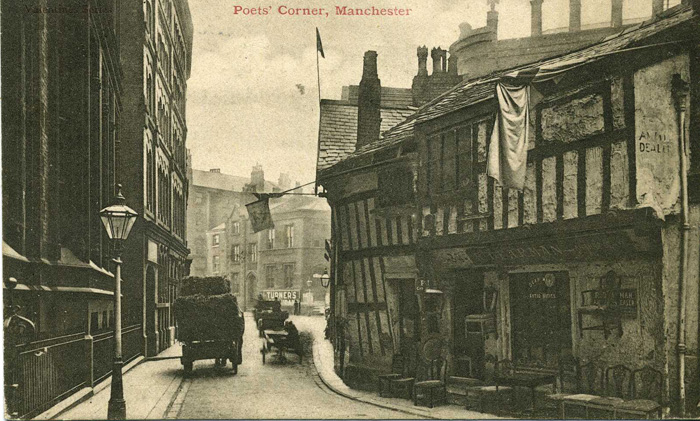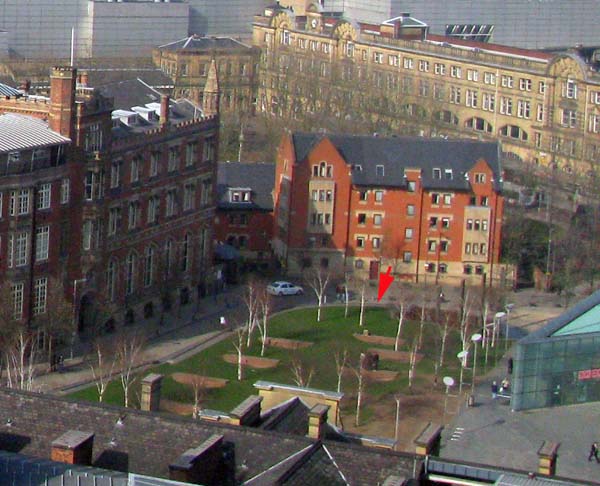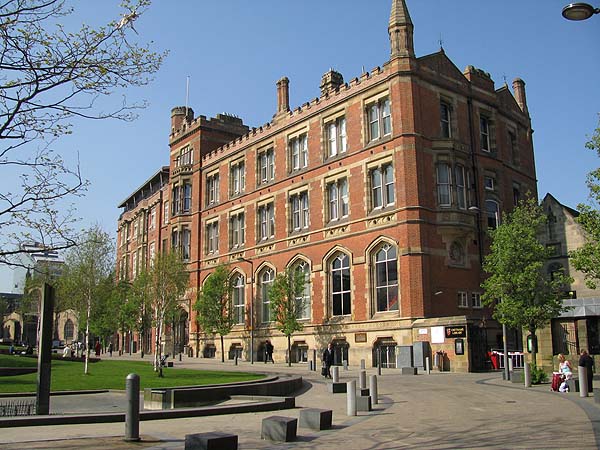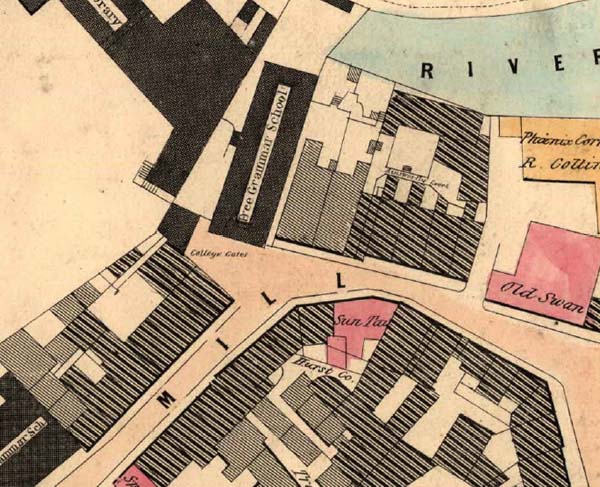|
Poet's Corner - Long
Millgate
 Today the piece of land bounded by Long Millgate, Todd Street, Corporation Street and Fennel Street contains the iconic Urbis museum building rising out of Cathedral Gardens. This wasn't always the case, in fact until as recently as the 1960s there was a variety of buildings within the block. Along Fennel Street there were a number of wholesale grocers with cellar warehouses. The postcard above shows the view at the point where Long Millgate curves towards Todd Street close to the gatehouse that marks the entrance to Chetham's School. That location is show in the photographs below. In the aerial image it is marked with a red arrow.    The half timbered
building that stood at this point was the Sun
Inn which is shown in the excerpt from the
Adshead Map of 1851, shown here with the
permission of Chetham's Library.
 In "A History of the County of Lancaster: Volume 4" the writers William Farrer & J. Brownbill said this of the Sun Inn: "The growth of the town has caused the destruction of nearly all the old gabled timber-and-plaster houses which were characteristic of Manchester streets at the beginning of the 19th century. Up to 1822, when the first widening took place, Market Street was chiefly composed of houses of this description, erected mostly in the 17th century, with here and there a later 18th-century brick building. One or two of such timber houses still remain, however, notably that in Long Millgate, formerly the Sun Inn, but now known as 'Poets' Corner,' which bears outside the date 1647 and the initials WAF" In a biography of the poet John Critchley Prince you can read this about the Sun Inn: "Near to the gates of Chetham College, in Long Millgate, stands one of those ancient and picturesque houses which occasionally start to view like spectres of a bygone age, but are now fast disappearing before the levelling hand of improvement. In external appearance it presents a singular contrast to the neat, uniform aspect of our modern mansions, being clumsily supported by irregular beams, and its walls being composed of clay and plaster. As far back as we have traced its history, it has been occupied as an inn, but we have been unable to ascertain the date of its erection from any accessible records. It exhibits evidence, however, of great antiquity, in one place bearing the date 1612, apparently inscribed to commemorate some alteration having taken place. The dwelling, which possesses a charm from its antiquity and the associations connected with its neighbourhood, is divided in the interior by awkward and ill-planned passages, such as are usually found in old habitations, though it contains one commodious apartment." The host of the "Sun Inn" at the time of which we now write was Mr. William Earnshaw, of whom it has been said that "he added to great urbanity of manner and kindness of disposition the attainments of a scholar and a gentleman, accomplishments rarely united in one of his calling;" and it appears that his knowledge of biblical literature was as extensive as remarkable, and that his admiration of literary men was warm and genuine." Here is where the name of Poet's Corner comes from. The Sun Inn became the haunt of a group of local poets. "The "Sun Inn," says Mr. Falkner......"soon became, through Prince, Bamford, Rogerson, and other literary men, the rendezvous of the rhyming fraternity of the county, and to its quaint snug parlour, the 'commodious apartment' referred to, were attracted many a genial soul, poets and their satellites, who enjoyed the wit and humour, gossip and melody, which nightly made its walls vocal." "The Manchester group: the most high-profile and prolific in the nineteenth century. The 'Sun Inn' group (named after the manchester pub where they met), went on to the launch the Lancashire Authors Association, and contributed to an anthology, The Festive Wreath (1842), edited by John Bolton Rogerson, which included contributions by John Critchley Prince, Isabella Varley, George Richardson, Robert Story, Robert Rose, Elijah Ridings, William Gaspey, Richard Wright Proctor, John Mills, Thomas Arkell Tidmarsh, John Scholes and Eliza Battye." ******************
As you can see in
the image above, in later years the building became
an "antiques" shop and was referred to as The Old
Curiosity Shop. |